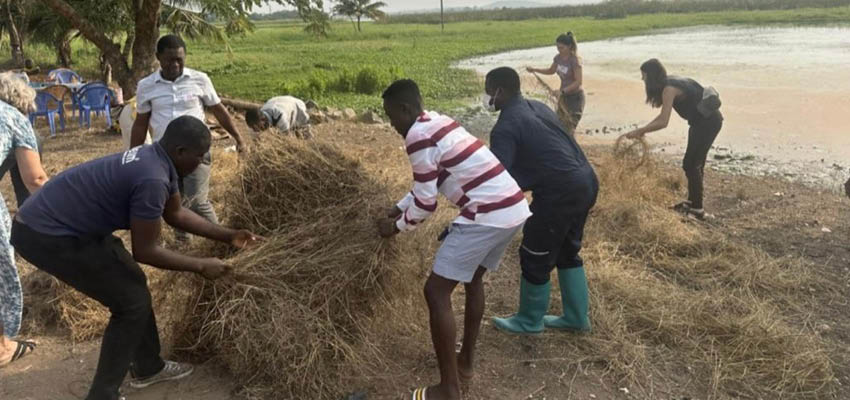
Monday, January 15, 2024
Monday marked the start of VISTA’s five-day Creative Capacity Building (CCB) Workshop in Kpong, Ghana. As the first day, Monday was partially reserved for introductions and building relationships between ourselves and the community and within the community.
After introductions, we kicked things off with an overview of the design process, led by MIT D-Lab Founding Director Amy Smith and translated by Johnson Asante. The design process consists of four overarching steps: Imagine, Create, Test, and Learn, each of which have associated substeps. Understanding the lifecycle of designing a new technology was an important stepping stone to introducing later parts of the workshop, including building small, useful technologies, all of which have undergone numerous iterations of the design process already. The design process is useful in that it provides a structured framework for people to follow when they are ideating individually or with a team. It’s important to equip people with ways to nurture their creativity, empowering them to feel confident in their ability to ideate a new venture or progress an existing idea.

Following our mini-lecture, we moved into an exercise dubbed the “Maize Raise,” which introduces the implementation of the design process on a small scale while promoting team building and creativity. In this activity, the group broke into teams of five to six people, including a mixture of community members, MIT students, and KNUST students/faculty. The goal was to support as many cobs of dried maize as possible using only two pieces of printer paper. The only requirement is that the maize needed to be elevated about six to eight inches. In order to simulate the design process, teams were given practice papers to test out different approaches. After a set amount of time, teams had two minutes to build their final design. Everyone came together, and each group demoed what they had built, adding cobs until failure.
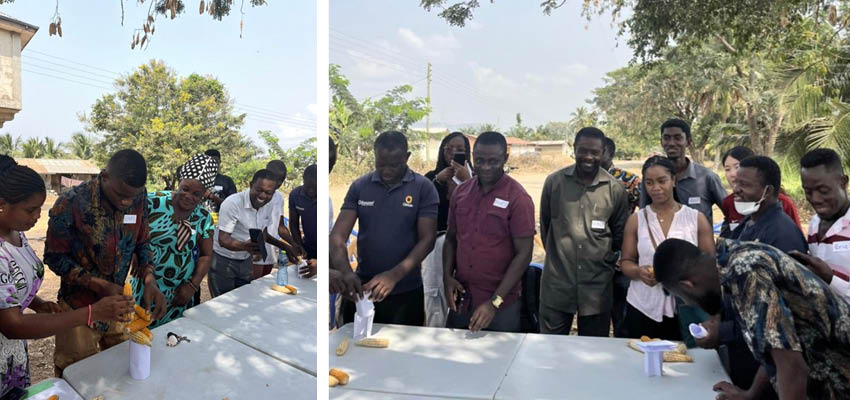
Following the Maize Raise, the group was introduced to the technology called a maize sheller. This technology is useful to expedite the arduous process of shelling maize by hand. Participants were shown demonstrations first using a plastic, mass-produced maize sheller, and then with a metal maize sheller that they could learn how to make. Participants were first taught proper sawing technique using hand saws and bench hooks. The group sawed two blocks of wood per person, one with a one-centimeter deep groove, to be used in building the maize sheller and later in the week for the charcoal press.

Then, participants were shown how to use tin snips and triangular files to cut and smooth sheet metal to the appropriate size (5cm x ~21cm) for a maize sheller. They used the block with the groove to bend each end of the sheet metal in opposite directions, which would later serve as a clasp.
Following this, they used metal jigs and hammers to create angled grooves along the strip of metal, starting at the ends and moving toward the center. They used pliers to bend the strip into a circle, ensuring that the grooves were pointing inward. Once bent, the ends could be folded into a clasp by using needle nose pliers to secure the sheller. To further secure the clasp, the participants placed a square metal rod through the sheller, and propped it up onto the wooden blocks. This then allowed them to hammer the clasp shut on top of the rod and finally nail two small dents into the clasp for extra security.
Building and testing out everyone’s maize shellers led us into the end of a successful first day!
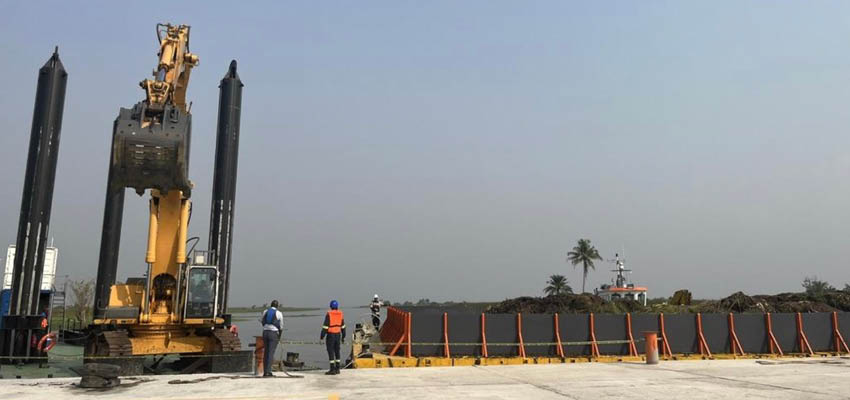
Tuesday, January 16, 2024
The second day of our CCB was defined by introducing a way to repurpose the invasive plants. At the beginning, Amy Smith introduced the group to a couple of different charcoal presses that had been previously developed at D-Lab. The goal of this discussion was to demonstrate the effectiveness of iteration in the design project by showing a charcoal press that was effective, but was costly, slow, and could be improved upon. Then participants were given the chance to try out the improved design of the charcoal press that resolved some of the pain points of the original.
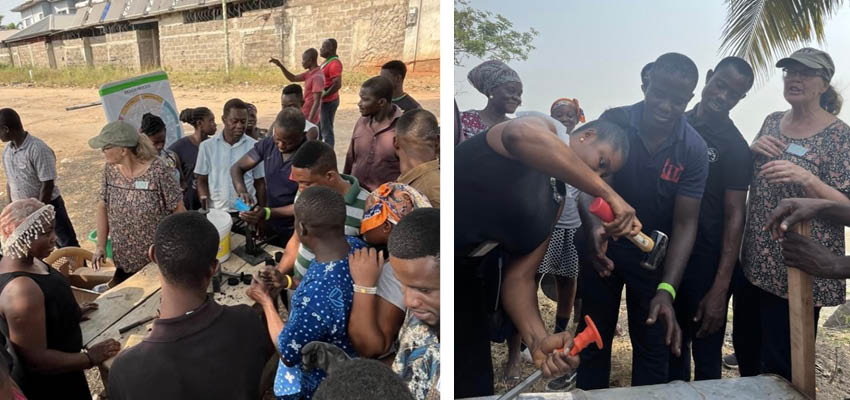
Following the mini lecture on iterative design, we moved into the first charcoal burn of the week. Dan Sweeney led a hands-on demonstration of how to properly chisel and prepare a metal drum for carbonizing biomass. In this first burn, we did one drum with maize cobs and the other drum with the dried weeds that had been drying since the day before.
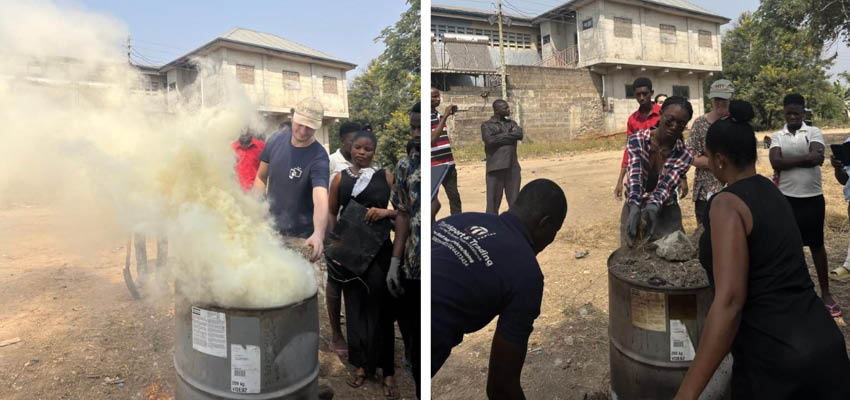
Following the charcoal burn, we moved into the first stage of constructing our individual charcoal presses. This included using the pieces of wood that the group had diligently sawed the day prior for the maize sheller. Then, each individual needed to utilize their hand saw skills to cut a third piece of wood for the charcoal press. Following this, the group was introduced to measuring, chiseling, and filing a small wooden hole in this third piece of wood, which would later serve them for the press and led us into the following day.
Wednesday, January 17, 2024
The day began with the community members finishing up chiseling the square holes in the tabletop for the charcoal press. Once the chiseling was complete, they used rasps to smooth out the newly formed hole.
Participants were taught how to use a hacksaw in order to create the two metal parts for the central component of the press. They cut slits into the edges of two hollow, rectangular pieces of metal, one with a larger cross-section than the other. Then, they used pliers to bend the sides of the metal to form an open box shape. The piece with the smaller cross-section was wrapped in a square of metal roof panels to form a flat surface for the charcoal.
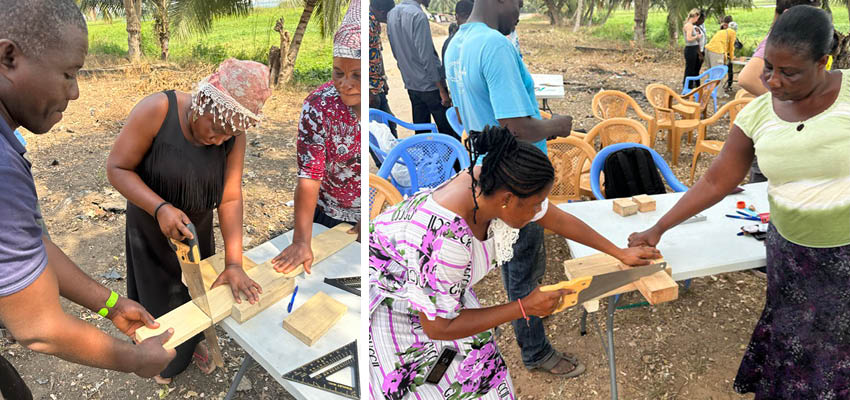
The next step in developing the charcoal press was to assemble the wooden 2x4 blocks that were cut for the maize sheller underneath the rectangular piece of wood with the square hole in the middle to form a structure that resembled the table. Participants were taught how to hammer the nail vertically into the wooden blocks to connect the different pieces.
After creating the different parts of the press, the participants transitioned to another charcoal burn. This burn was two minutes shorter for the weeds to try and prevent the development of ashes. It was two minutes longer for the maize mixture in an effort to improve the carbonization of the biomass.
The group gathered to observe the process for creating the charcoal mixture. A 1:1 ratio of water to cassava powder was mixed to form a diluted version of a Ghanaian dish known as kokonte. This was added to a 1:2 ratio of kokonte to boiling water, which was thickened in a coal pot. This starch was used as a binder for the charcoal briquette. The starch mixture was added to charcoal powder, an amount equivalent to the amount of cassava.
Finally, the group assembled their charcoal presses and created their briquettes. This process involves inserting the plunger into the metal frame in the center of the press and hammering down to compress the charcoal mixture into a briquette.
Participant Victoria uses her new charcoal press to create briquettes while her daughter plays
next to her.
Participant Divine shows off his charcoal briquette to
the group.
Fishmonger Mabel places a tray of charcoal briquettes on top of MIT student Sanjna’s head, who wants to practice this common method of carrying goods performed by Ghanaian women.
The facilitators of the workshop from KNUST and MIT finished the day by observing the manual harvesting of the weeds. A group of the harvesters took us via canoe to the island of weeds. A man with a machete hacked apart sections of the weeds. At the end of the day, these weeds were pulled ashore with a rope.
A manual harvester chops off a section of weeds with a machete.
Thursday, January 18, 2024
Thursday began with a unique and exciting introduction to the day: observing and taking turns manually pulling the weeds harvested from the day before out of the lake. After one of the locals cut apart the mass of weeds we had pulled ashore yesterday with his machete, the harvesters used their handmade wooden tools to grab the weeds and drag them up the muddy shoreline onto the dry street. In the series of four images below, the full harvesting process is depicted.
After we finished our harvesting lesson, we returned to the workshop area with a welcome back, charcoal update, and a brief introduction of IDDS and co-creation. As we shifted away from the skills-building part of the workshop into the team-building and ideation stage, we decided to introduce these concepts with a hands-on activity meant to teach lessons about teamwork and the value that different people, tools, and perspectives bring to a team.
This activity involves individuals using unique tools to collect marbles, progressing to collaborative rounds where teams strategize and creatively combine tools. The core importance lies in fostering teamwork, appreciating individual contributions, and learning the value of co-creation as participants navigate challenges and adapt strategies collectively. The two images below show the activity in action.
Next, we split into five groups to begin the idea generation process which would later feed into potential projects for IDDS. The goal here was not yet to develop solution technologies, but rather to identify and understand the most pressing problems that people faced in their everyday lives. In each group, we tried to evenly distribute the fishermen, fishmongers, weed harvesters, as well as the D-Lab and KNUST students. We stimulated the conversation with questions such as:
- What are tasks in your life/work that are difficult?
- What are ways that you could earn money?
- What are the challenges that face the community?
We recorded responses on small sheets of paper, each one with a brief title/description of the project and a representative sketch. Then we began to sort and prioritize the projects to choose the top 3-5 ideas. Some groups used a voting system to choose the ideas, and others just discussed amongst themselves which were the most important.
Finally, we all came back together and each group presented their top 3-5 ideas that were selected. These ideas include, but are not limited to:
- Waste management / collection
- Fish preservation
- Challenges while fishing (canoe safety, fish hiding under the weeds, competition from
- dynamite fishers, difficult to paddle canoes)
- Intermediate technology to facilitate the manual harvesting, pulling, and mud separation
- Efficient drying of the weeds
- Alternative uses for dried weeds (charcoal, mats, manure)
We concluded the day with a prayer and a brief closing.
After the workshop, we took a trip with all the students to Akosombo Textile Limited (ATL), a textile manufacturing company based along the Volta River. The company produces a variety of textiles, including prints and wax prints, which are popular in West African fashion. We toured the factory and observed the fascinating processes involved in wax printing. After the design is digitally rendered, the fabric is stamped or printed with hot liquid wax using engraved metal rollers. The porous rollers play a crucial role in this process, as they absorb and evenly distribute the wax or dye onto the fabric. Additionally, we had the opportunity to purchase fabric from the factory and bring it to a tailor to make our own clothes.
To fuel the factory, ATL recently built its own Biomass Boiler Plant to convert electricity by burning organic materials, such as wood, agricultural residues, or dedicated energy crops and fuel the factory. ATL expressed interest in working with the dried water weeds as fuel, however, the biomass input into a biomass power plant should ideally have a consistent and relatively high caloric value to ensure efficient energy production. Biomass with higher caloric content, such as coconut shells with low moisture content, is preferred as it can yield more energy during combustion, contributing to the overall efficiency of the power generation process. Thus, the process we introduced this week of converting the weeds to charcoal, could prove incredibly valuable for the community moving forward.
Friday, January 19, 2024
Friday was our big showcase day! To start the day, we split up into our three groups, with the community members each choosing the activity they were most excited about sharing. Once assembled, the groups planned who was giving the presentation and decided upon the most important information to convey.
In my maize sheller group, Mabel immediately volunteered, shouting “It should be a woman!” The rest of the team excitedly began assembling corn shellers, starting a new one at each intermittent step to allow Mabel to thoroughly explain the process. Then, our team chose Gabriel to inform the crowd about the ripple workshops happening the next week. Before we knew it, the people representing the VRA and ATL had arrived. Everyone worked together to move the chairs and set up each station.
The presentations went off without a hitch! Mabel set the tone by speaking confidently and loudly and conveying the immediate impact that the maize shellers would have on farmers and the community as a whole. Next, the group moved to the second station to watch as a new batch of Kokonte was made and the charcoal-making process was described flawlessly. Lastly, the group executed a burn using the big drum.
Mabel explains the corn shelled steps and product with team.
The VRA and ATL attendees were thoroughly impressed, asking numerous questions at each station as well as trying out the maize shellers for themselves!
Unfortunately, at the end of the day, the time had come for some of the students to say their goodbyes. WhatsApp numbers were exchanged as well as recorded in Lewis’s notebook. I think I can speak for all of us students when I say that saying goodbye was extremely challenging as we had all gotten to know the community members very well. This workshop was incredibly impactful for us all. Personally, I was in awe of the ownership of the learning process that the community members displayed as well as the pride that they displayed during this showcase day.
VRA employees testing out the charcoal press during the demonstration.
Saturday, January 20, 2024
On Saturday, we were so fortunate to visit Aflive, an island along the Volta River with village communities. This was home to one of our community partners, Eric, who helped us with coordinating the CCB workshops and introducing us to community members who were interested in our CCBs. Eric was a harvester for the aquatic weeds in the Volta River in Kpong, but was raised in Aflive with his brother Divine, both of whom accompanied us to Aflive. We drove for three hours from Akosombo towards the Ada region, and took a short boat ride to the island. The island was beautiful -- lined with coconut trees and sugar cane fields separating the village communities. Walking through the island, we noticed that the severe impact of the flooding in November was still present. We saw remnants of chapels and homes that had been affected by the flood and could feel the sand still damp under our feet that used to be warm and dry.
Eric’s family greeted us warmly, and we met several members of his family and community, including his mother and grandma. They welcomed us with fresh coconuts from trees by their home, which we had the opportunity to drink from and eat. We saw large clay pots that are commonly used after years of making and baskets that were constructed from dried leaves. They explained how welcoming they were of our presence and ongoing work at D-Lab and we conveyed our appreciation of their hospitality in allowing us to visit their beautiful home.
We then walked to the neighboring village, where we witnessed community events, performances, and a gathering for a celebration of life. We learned about the sugar cane rum production in this community -- from how the canes are harvested and pressed, to how the water is collected and then distilled and fermented. We saw the sugar cane stalks that were dried out after being pressed, and discussed how they were used by other sellers or for burning.
We journeyed back to Eric’s village, and his family provided us with a lovely and delicious meal, including fish, fresh crabs, and kokonte.
We walked through the village to see more of the community and the homes before heading back towards Akosombo. The village and Aflive were so beautiful, and this day was an incredible highlight of our trip. Everyone was so kind and answered our questions and told us about their experiences, and we are so grateful for the opportunity to learn more about life along the Volta River.
More information
MIT D-Lab Research: Charcoal from Water Hyacinth
Contact
Dan Sweeney, MIT D-Lab Research Scientist

